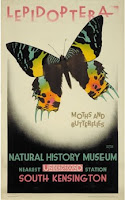I’ve been contributing quite a
lot of material to a new book which is published this month on 12th November, Classic Rock Posters by Dennis Loren and Mick Farren. It tells the
history of rock and roll through the posters that announced it, and there’s
some great artwork in its pages (also available in French and Italian, I
believe – a great Christmas present!).
Austin Cooper (1890-1964)
Working on it earlier this year
reminded me of my poster-designing ancestor Austin Cooper, about whose career I’ve written here before. He worked mainly for public transport companies – the London
and North Eastern Railway, and the London Underground. The work usually took
the form of a particular series, a particular marketing angle, for example a
set of posters for market towns or for destinations with a literary connection.
London Underground’s 1928 poster campaign focused on
sections within museums
On at least three separate
occasions the Underground asked him to deliver campaigns encouraging the use of
the Tube to travel to London’s
world-class collection of museums. In 1928 and 1932 Cooper highlighted
particular collections within each featured museum, while in 1930 he devoted an
entire series to one institution, the British
Museum.
London Underground’s 1930 British Museum campaign highlighted the very unBritishness of its internationally
sourced artifacts
It’s interesting to see the
development of his style over the four or five years represented by the
campaigns. At LNER he succeeded the artist Noel Rooke, who is credited with
reintroducing the woodcut as a graphic style, something clearly visible in
Austin Cooper’s own early work and still apparent in some of these museum designs.
London Underground’s 1932 poster campaign once
again featured a number of museums for which Cooper emphasised particular
aspects
Austin was a master of the typeface too. By the Second World War he had tired of commercial commissions and concentrated on fine art for the
remainder of his career. But Cooper's contributions to poster art through his work,
his teaching and his text book remain highly influential today.















No comments:
Post a Comment